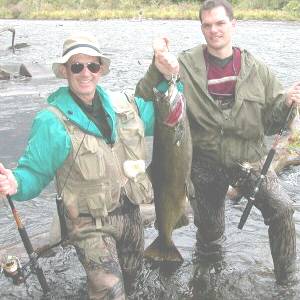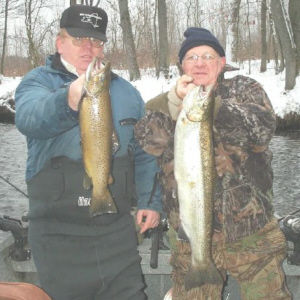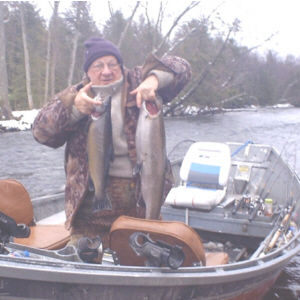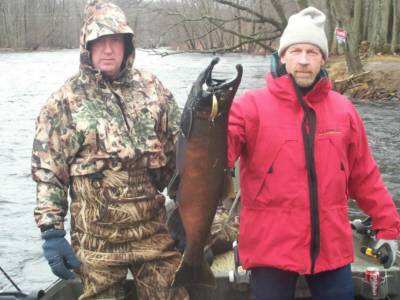 |

|

|
 |

|

|
|
The Salmon River flows from the Tug Hill Plateau and pools into a man-made reservoir. The River gets its start at the Lighthouse Hill Reservoir near Altmar. From here the river has a 12 mile stretch that is open to the public for fishing for Atlantic Salmon, Brown Trout, Chinook Salmon, Coho Salmon, and Steelhead. The river passes through the middle of Pulaski NY making it the salmon capital of the world. From there it flows into Lake Ontario at Port Ontario. The Salmon River can be fished by anglers from shore, by wading, or by driftboat. If wading the river be sure to use corkers these are metal cleats that attach to your boots. The rocks on the bottom of the river at flat and very slippery. Water levels are prone to rise quickly since its waters are used to generate hydro electricity. Be prepared to exit the river if water rises quickly. Fishing the Salmon River is a experience of a lifetime. The river holds the NY state record for Chinook Salmon. This fish was caught by Kurtis L. Killian on a orange fly from the Salmon River September 07, 1991 this awesome fish weighed an amazing 47 lb. and 13oz. The river is also known to give up many steelhead over 20 pounds each year. As this article is being written there is a rumor of a Rainbow Trout thas was caught from the Salmon River that was just a half pound off the NY state record of 26 lb. 15oz. All of this fantastic fishing is made possible by the Salmon River Hatchery, located in the Village of Altmar in Oswego County. It is here that the DEC will collect the eggs of the migrating Atlantic Salmon, Chinook Salmon, Coho Salmon, Brown Trout, and Steelhead. The Salmon River Hatchery produces about four million trout and salmon each year. These fish are stocked across the state at various locations and are the source of the successful pen rearing projects that have helped to return fall salmon fishing to the streams of the western end of Lake Ontario. This project was started because the fish had become so imprinted on the Salmon River that all the fish were returning here. By raising the salmon in the pens in other streams for a few months they are able to imprint on that stream and will return back there in the fall creating more fishing opportunities for NY fisherman. The Salmon River Hatchery is open to the public from 9 a.m. to 4 p.m. seven days a week from March 15 to November 30. In the fall a trip through the Salmon River Hatchery should be combined with a scenic trip to see the fall foliage making for an exciting outing for the whole family. At the hatchery there are informative exhibits, including mounted and live fish exhibits. The Salmon River is alive and well and is a wonderful resource that all New Yorkers should be able to share and be proud of. This world class fishery has become world famous and has drawn people from around the globe to enjoy its scenic beauty and wonderful sport fishing. |
| The date was September 29, 2003 when Wayne W. and Wayne A. Baci were fishing on the Salmon River in Pulaski, NY. They caught this very nice 25 pound King salmon that was 36 inches long. Sometime in mid September the salmon begin to run up the Lake Ontario tributaries to spawn. The run can last until early November and provides anglers with a fantastic fishing experience. Then in late October the steelhead will enter the stream and feed voraciously on the drifting salmon eggs, providing an even more exciting angling adventure. |

|

|
This is a huge 44 inch king Salmon caught by Noam D. Freedman. It was caught on the Salmon River October 2000 from the School House Hole. Despite some bad luck he was able to bring this monster under control. It's a trophy for sure! Salmon fishing is at its best usually the first two weeks in October. Then it starts to slow down, but then the steelhead move in to fill the void! Silver torpedos in ice cold water, man thats something! |

|

|
|
Drift Boat fishing on the Salmon River can be a very exciting and productive way to spend a day. Having always wanting to give it a go Raymond Martin of Elmira, NY and Jim Cleary from Big Flats NY took and drift boat trip down the Salmon River with Shane Thomas of Gottum Guide Service. There is more to drift boat fishing than one would imagine. The flow of the water the water temperature and coloration are all factors that must be considered. Shane worked very hard to make their trip a success. He would stop ahead of each spot and pick the appropriate type and size of lure for the water conditions. He would test each lure in the water and tune it if necessary. Each lure would receive a hook sharpening to make sure they were razor sharp. Flatfish, Hot Shots, and Kwikfish of various sizes and colors were the main plugs used. Once all the lures were tuned and sharpened we would let the lures out and place the rods in the holders. Then we would inch down the river with all 5 rods out over the front of the boat presenting our offerings to the fish. The beauty of a driftboat is you can row back up stream and present the offerings to the fish several times. Sometimes a strike would be savage from a fish defending its territory other strikes would be subtle from a fish looking for a quick meal. Either way you will know it when that rod bends over and the fish takes to the air in an attempt to throw the hook. Certain sections of the river that are not fishable with plugs but still have fish holding in them would require them to stop and fish with flies or egg sacs. When the fish are not moving much and seem lethargic flies and egg sacs will often temp fish that would not hit a plug. If wading the river be sure to use corkers these are metal cleats that attach to your boots. The rocks on the bottom of the river at flat and very slippery. |
| The date was January 3, 2005 when John Whittmier & Tim Hogan of Connecticut were on a exciting mid winter drift boat trip on the Salmon River. They were fishing with Shane Thomas of Gottum Guide Service. They were fishing the Schoolhouse Pool with a water level of about 2500 cfs. Thats when this amazing very late run Coho Salmon attacked the T4 flatfish they were using. The Coho weighed in at 20 pounds and John is going to have it mounted. |

|

|
|
|
|
|
|